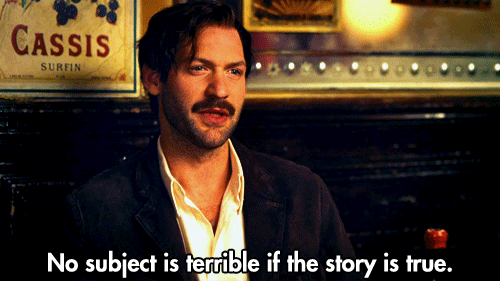You’re Not Smart Or Interesting For Shitting All Over Popular Culture
“Highbrow” v “lowbrow” is dead. It’s time we started acting like it.

Popular culture has endured a long history of being the ‘joke’ of the art world and its punchline. Picasso, Beethoven (musician) and Shakespeare are considered transportative, meaningful, life-changing and serious, whereas Hoarders, Beethoven (dog movie) and Nicki Minaj are a guilty pleasure at best, or the trash that’s corrupting the nation’s youth at worst.
In this recent article for The Guardian, a film critic deigned to leave the art house and slum it in the cinemas and go and see Captain America: Civil War. After subjecting himself to this horrid ordeal, his reaction is best summed up by this line: “How can audiences stand this?”
Now, there’s nothing new or noteworthy or even interesting about a film critic who doesn’t enjoy a movie, and I’m certainly not saying that Captain America is a flawless film (although that scene where he flexes a helicopter to breaking point is Oscar-worthy). But it’s high time that we recognise the outdated thinking behind attacks like this – not on movies, but on us, the audience. The (many) people who like this work are also tarred with that same brush, and are seen as being dumb, ignorant, uncultured or naive.

This is trash talk and garbage words, which we should be angry about.
—
The Inherent Stupidity Of “High” vs “Low”
The argument that ‘highbrow’ culture is better than ‘lowbrow’ culture feels like it’s been going for centuries. It will probably continue when we’re all ethereal beings made of pure thought claiming that moonbeams are trashier than sunlight. I’m not going to continue that argument, because this isn’t a high school debate, but more importantly because it’s a false dichotomy. It’s an incomplete premise. It’s dumb.
This arbitrary binary relies on the idea that some art forms are inherently smart, deep and rewarding, while the rest are just dross to be consumed with guilt, if at all. A classic work of literature — let’s say War and Peace — is better than a reality TV show about famous people — Keeping Up the With the Kardashians, so the thinking goes. One has deep meaning and transporting prose; the other has selfies and lip liner.
But why are we judging these things side-by-side at all? As entertainment, and as art, they’re both fulfilling the function of their specific medium or genre well. Keeping Up With the Kardashians is a trailblazing and effective form of reality TV which gives people pleasure. If it’s going to be compared to anything, it should be a work like Channel Ten’s short-lived The Shire. The Shire is not worse than Kardashians because it’s “trashy” — it’s because it’s a shit example of the genre.
Grouping art into these fictitious opposing teams is made even more ludicrous when you consider how subjective the statuses of “highbrow” and “lowbrow” actually are. Sometimes all it takes is an artist’s or author’s death to reclassify their work. Van Gogh never sold a painting. Shakespeare wrote for the masses, and is now seen as an essential literary experience.
This bizarre transformation can occur during a creator’s lifetime too. Kurt Vonnegut spent years utilising elements of the sci-fi genre like time-travel and aliens in order to enhance the poetics and drama of his novels. In his book of essays Wampeters, Foma and Granfalloons, Vonnegut spoke about how this affected his critical reception: “I have been a soreheaded occupant of a file drawer labelled ‘science fiction’, and I would like out — particularly since so many serious critics regularly mistake the drawer for a urinal.”
Vonnegut eventually had his wish granted. After spending many years being labelled as a sci-fi writer (and even a pornography writer for some reason) he made the shift into the literary genre, which led to every morose teenage guy making fun of people reading The Hunger Games while clutching a copy of Slaughterhouse Five.
—
Lowbrow Or ‘The Bottom Of The Ladder’
The construction of both highbrow and lowbrow is designed to create a hierarchy, to impose an artificial order of importance. Designating something lowbrow is another way of making sure it’s regarded as unimportant in the grand scheme of things; at the bottom of the ladder. The motivations for doing this are often related to other forms of cultural dominance. It’s no coincidence a large majority of the most famous works in history have been made by old white dudes.
Another genre of novel that’s often considered trash is the much maligned romance genre. The ‘nemesis’ of the romance genre tends to be the literary novel, which is generally considered to be highbrow automatically, in that it’s the pinnacle of the writing craft. However, the literary novel is simply a genre like anything else, like thrillers and sci-fi and erotica. It’s more difficult to define — one of the ways to define ‘literature’ is often by the fluidity of its definition, but in general, it’s about focusing on enhanced poetics and themes, in comparison to a crime novel, which revolves are a strong, crime-based plot.
The romance community is incredibly interesting because they do completely fine on their own – they already have their own, almost completely female, readership, infrastructure and setup, which exists separately but uneasily beside ‘mainstream’ literature. It’s also no coincidence that this is a highly gendered genre, dominated and run by women, for women. So much of what is considered highbrow is defined by where it fits in a culture that is dominated and run by straight white men, meaning that almost exclusively, art produced by and for straight white men is considered highbrow canon. Let’s also ignore the fact that romances regularly top the bestselling lists.

You said it, fake Hemingway.
Yet despite all this, there’s still the fight for recognition. Recently, romance readers were lobbying for the genre to be included at the Sydney Writers Festival. It wasn’t so much a desperate need to be accepted by highbrow – or even mainstream – literary communities, but rather the fact that they were being misrepresented, with ‘romance panels’ featuring literary authors who use ‘romantic elements’ in their stories. Frankly, any story without some sort of romantic element is a rare find. It’s wrong to judge a literary genre novel with the same critical apparatus as you would a romance novel – and vice versa.
Now, the world does not need another white dude’s opinion on Beyonce but it’s interesting to see how someone of her skill and profile can be subjected to the same treatment. Just look at the backlash she received for that now infamous Superbowl halftime performance, where she sang ‘Formation’ off her album Lemonade, with backup dancers dressed as Black Panthers. A very sad protest was organised accusing her of hijacking the event with “hate speech and racism”.
There’s a part of being considered ‘lowbrow’ which includes knowing your place – Beyonce had been given permission to entertain during the halftime show, yet she pushed the boundaries of what her performance entailed. It was pop music, but it was also a protest with a political point. An easy way of devaluing her point is to dismiss her method of delivering it.
—
Highbrow Good, Lowbrow Bad, People Are Idiots
Cutting up the world into two kinds of arts also means making snap judgements about the inherent worth of the people who are consuming each style. People at the arthouse cinema are smart and cultured, while the peons watching the latest Spiderman incarnation are big dumbos who need to be educated. Highbrow: good, lowbrow: bad. This is not hyperbole – this kind of thinking is an elitist attack, and can be best demonstrated by the actual origin of the highbrow and lowbrow terminology.
In his book The Myth of Popular Culture, Perry Meisel says: “The terms ‘highbrow’ and ‘lowbrow’ come from phrenology, the 19th-century science of regarding the shape of the skull as a key to intelligence. A ‘high’ forehead meant intelligence; a ‘low’ one meant stupidity. Phrenology thrived as a popular science in the late 19th century and led eventually to the racial theories of the Nazis, for whom the Jewish cranium and pale, sunken face were clear indications of Jewish racial inferiority.”
The perpetuation of lowbrow as a concept is such an insult it’s almost literally a Hitler thing to do.
This thinking is obviously outdated. These days, there is so much smart, incisive and critical writing being done about popular culture, about the ‘lowbrow’. It’s just as likely that we’ll find an article about superheroes in the New Yorker as we will a review about the next critically-lauded literary novel. Traditionally this kind of critical apparatus was saved for a very specific kind of art — but we’re now considering all these art forms from that mindset. When we’re discussing a book of selfies seriously, it seems impossible to me that we’re mindlessly consuming them. When we’re analysing a superhero movie about whether or not it succeeds as a superhero movie, rather than as an amorphous concept of ‘good’ or ‘bad’ art, it shows that we’ve moved beyond the old paradigms.
So when we’re accused of enjoying lowbrow art, not only are we definitely being insulted — we’re being insulted by someone who doesn’t understand the art that they are deriding.
–
Patrick Lenton is a writer of theatre and fiction. He blogs at The Spontaneity Review and tweets inanity from @patricklenton.

